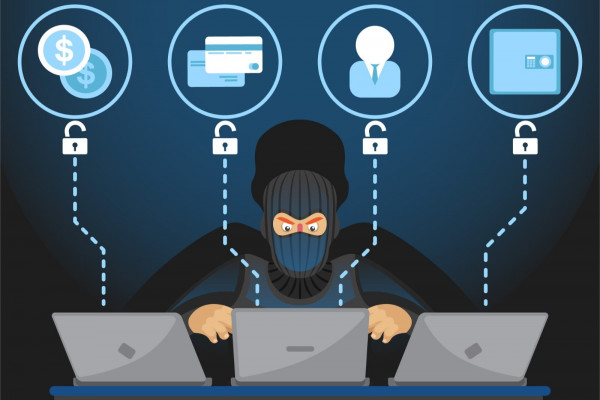The integration of artificial intelligence (AI) into both cyber defense and cyber offense is reshaping the threat landscape. As hackers harness AI and machine learning to develop more advanced attack methods, organizations must evolve their defensive strategies to stay ahead. This blog explores six emerging ways hackers are leveraging AI and provides actionable steps to protect your business with cutting-edge cyber security services, and how STL Digital can assist your organization in keeping hackers at bay.
Key Statistics:
- According to KPMG Security Operations Center Survey 2024, cyber threats are escalating with financial losses projected to reach a staggering $10 trillion annually in 2024.
- In the survey of KPMG Security Operations Center Survey 2024, 70% of security leaders believe AI will be a game-changer in cybersecurity.
- Gartner Generative AI predicts that by 2024, 40% of enterprise applications will have embedded conversational AI, up from less than 5% in 2020.
1. AI-Driven Phishing and Social Engineering
Hackers are now deploying sophisticated Artificial Intelligence algorithms to craft highly personalized phishing emails and social engineering messages. These attacks use machine learning to analyze publicly available data, from social media profiles to online behaviors, to create deceptive communications that mimic trusted sources. The result is an increased success rate for phishing scams, making it more challenging for employees to discern legitimate messages from malicious ones.
Stay Ahead Tip:
Invest in robust cyber security services and employee training programs to recognize and respond to phishing attempts. Partner with a managed security service provider that leverages AI-driven threat intelligence to filter out phishing emails before they reach your inbox.
2. Automated Vulnerability Scanning and Exploitation
Traditional vulnerability scanning methods are being outpaced by automated tools powered by AI. Hackers use these advanced systems to continuously monitor networks for weak points, and once vulnerabilities are detected, they can launch rapid exploitation attacks. This AI-powered automation minimizes the window for defense, enabling attackers to compromise systems before patches or fixes are implemented.
Stay Ahead Tip:
Ensure your organization deploys advanced SOC Services that integrate AI to detect and remediate vulnerabilities in real time. Regularly update and patch systems, and work with Cyber Security companies that offer continuous monitoring solutions.
3. Adversarial AI Attacks on Machine Learning Models
Cyber criminals are increasingly targeting the very AI systems designed to protect organizations. By introducing subtle perturbations into the data input, attackers can manipulate machine learning models—a process known as adversarial attacks. These attacks can cause a security system to misclassify threats or ignore them altogether, thereby creating hidden backdoors for further exploitation.
Stay Ahead Tip:
Implement rigorous testing and validation procedures for AI models. Use adversarial training techniques and collaborate with experts who specialize in AI and cybersecurity to safeguard your systems against manipulation.
4. Deepfakes and Synthetic Identity Attacks
Deepfake technology has matured to a point where it can create convincing fake videos and audio clips. Cybercriminals use these techniques to impersonate company executives or trusted partners, gaining unauthorized access to sensitive information or initiating fraudulent transactions. Synthetic identities generated by AI can bypass traditional identity verification methods, leading to financial and reputational damage.
Stay Ahead Tip:
Incorporate advanced biometric and multi-factor authentication measures to verify identities. Leverage AI-based identity verification tools that are part of a comprehensive suite of cybersecurity services to detect and block deepfake attempts.
5. Ransomware Evolving with AI Capabilities
Ransomware remains one of the most lucrative cybercrime avenues for hackers, and AI is intensifying its impact. AI-powered ransomware can analyze an organization’s network in real time, identify the most critical data assets, and target them selectively. Additionally, these sophisticated strains can adapt their attack strategies based on network defenses, increasing the probability of a successful breach.
Stay Ahead Tip:
Deploy robust endpoint protection and backup solutions that incorporate AI-driven analytics to identify unusual data access patterns. Partner with a reputable Cyber Security Companies that offer proactive ransomware defense and incident response services.
6. Exploiting Gaps in Security Operations Centers (SOCs)
Even the most advanced SOCs can become targets if not adequately equipped to handle AI-powered attacks. Hackers may use AI to overwhelm SOCs with false alerts or mask their activities, making it challenging for human analysts to differentiate between genuine threats and noise. This strategy not only delays response times but can also lead to critical threats going undetected.
Stay Ahead Tip:
Enhance your SOC capabilities by integrating AI-driven automation and analytics. According to the KPMG SOC Survey 2024, 85% of security leaders are confident in their SOC’s readiness to deter future sophisticated attacks, yet continuous improvement is key
Invest in next-generation SOC Services that provide real-time threat intelligence, and consider partnering with a managed security service provider to supplement in-house capabilities.
How to Stay Ahead in an AI-Driven Threat Landscape
Leverage Cutting-Edge Cyber Security Services
In an era where hackers continuously innovate, organizations must stay proactive. Engage with cybersecurity services that incorporate the latest AI and machine learning techniques to detect, analyze, and neutralize threats swiftly.
Partner with a Managed Security Service Provider
A managed security service provider (MSSP) can offer around-the-clock monitoring, rapid threat detection, and an effective incident response. MSSPs help bridge the gap between evolving threats and limited in-house expertise, ensuring your defenses are always up to date.
Invest in Next-Generation SOC Services
Your Security Operations Center (SOC) is the nerve center of your cyber defense. Modernizing your SOC with AI-powered tools enhances your ability to sift through vast amounts of security data, reduce false positives, and focus on genuine threats. Continuous investment in SOC innovation is critical for maintaining a robust security posture.
Prioritize AI Innovation and Employee Training
AI and Cyber Security are interconnected fields that demand ongoing research and training. Keep your team updated with the latest AI innovation trends and provide regular training sessions to help them identify and respond to advanced threats. A well-informed workforce is your first line of defense against AI-powered attacks.
Establish a Proactive Risk Management Framework
Develop a comprehensive risk management strategy that addresses AI-specific threats. Implement robust testing protocols, invest in regular audits, and ensure compliance with emerging regulations to mitigate vulnerabilities before attackers can exploit them.
Conclusion
Hackers are evolving, and AI is proving to be a double-edged sword—empowering both defenders and attackers. As cyber threats become more sophisticated, organizations must adapt by embracing advanced cyber security services, modernizing their SOCs, and partnering with reliable managed security service providers. By prioritizing AI innovation and maintaining a proactive risk management strategy, you can stay one step ahead of cyber adversaries.
Staying ahead in this dynamic environment is not optional—it’s essential. Embrace the challenges, invest in robust security measures, partner with STL Digital, and foster a culture of continuous improvement in ai and cybersecurity to protect your organization against tomorrow’s threats.



